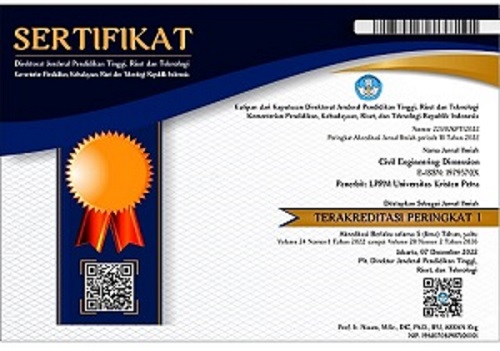Comparison Between 2-D and 3-D Stiffness Matrix Model Simulation of Sasw Inversion for Pavement Structure
 :
:
https://doi.org/10.9744/ced.9.1.pp.%2042-48
Keywords:
2-D and 3-D stiffness matrix model, SASW, pavement structure.Abstract
The Spectral Analysis of Surface Wave (SASW) method is a non-destructive in situ seismic technique used to assess and evaluate the material stiffness (dynamic elastic modulus) and thickness of pavement layers at low strains. These values can be used analytically to calculate load capacities in order to predict the performance of pavement system. The SASW method is based on the dispersion phenomena of Rayleigh waves in layered media. In order to get the actual shear wave velocities, 2-D and 3-D models are used in the simulation of the inversion process for best fitting between theoretical and empirical dispersion curves. The objective of this study is to simulate and compare the 2-D and 3-D model of SASW analysis in the construction of the theoretical dispersion curve for pavement structure evaluation. The result showed that the dispersion curve from the 3-D model was similar with the dispersion curve of the actual pavement profile compared to the 2-D model. The wave velocity profiles also showed that the 3-D model used in the SASW analysis is able to detect all the distinct layers of flexible pavement units.Downloads
Published
2007-04-03
How to Cite
Rosidi, S. A. P. (2007). Comparison Between 2-D and 3-D Stiffness Matrix Model Simulation of Sasw Inversion for Pavement Structure. Civil Engineering Dimension, 9(1), pp. 42-48. https://doi.org/10.9744/ced.9.1.pp. 42-48
Issue
Section
Articles
License
Authors who publish with this journal agree to the following terms:- Authors retain the copyright and publishing right, and grant the journal right of first publication with the work simultaneously licensed under a Creative Commons Attribution License that allows others to share the work with an acknowledgement of the work's authorship and initial publication in this journal.
- Authors are able to enter into separate, additional contractual arrangements for the non-exclusive distribution of the journal's published version of the work (e.g., post it to an institutional repository or publish it in a book), with an acknowledgement of its initial publication in this journal.
- Authors are permitted and encouraged to post their work online (e.g., in institutional repositories or on their website) followingthe publication of the article, as it can lead to productive exchanges, as well as earlier and greater citation of published work (See The Effect of Open Access).
















